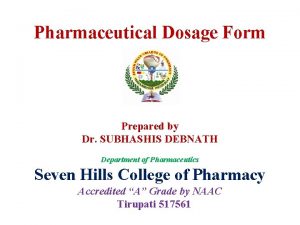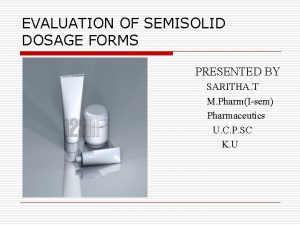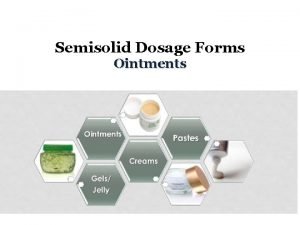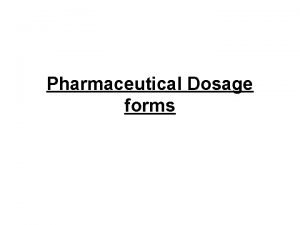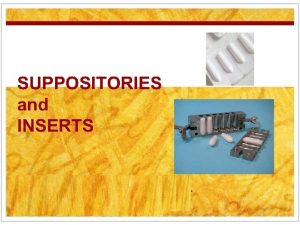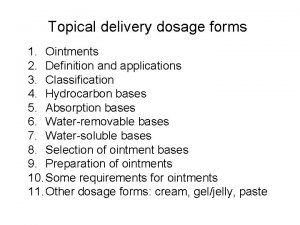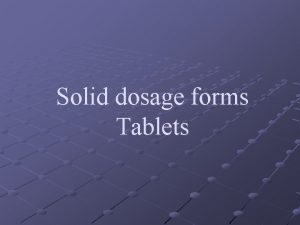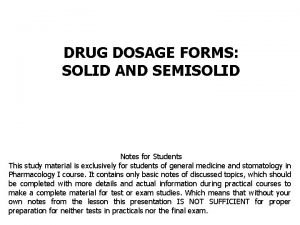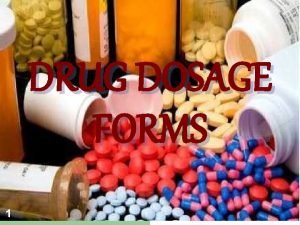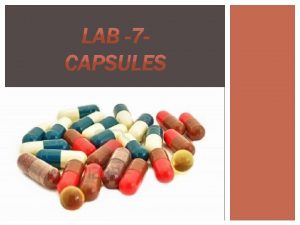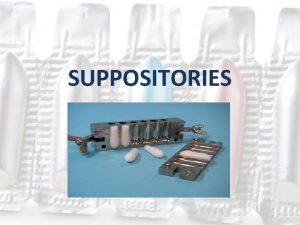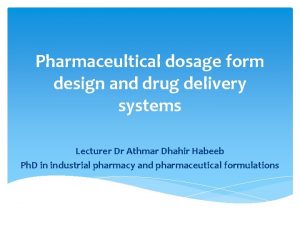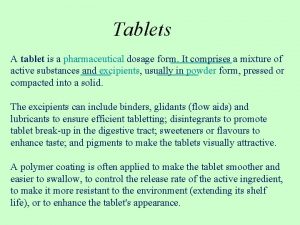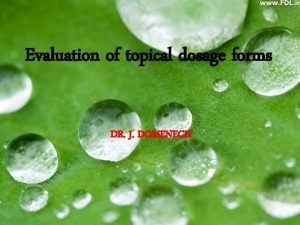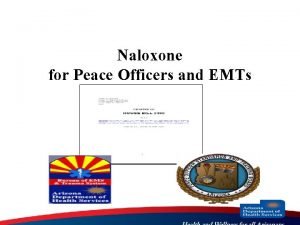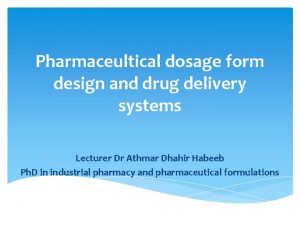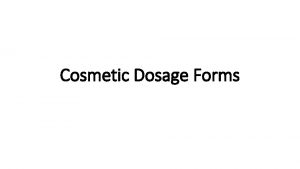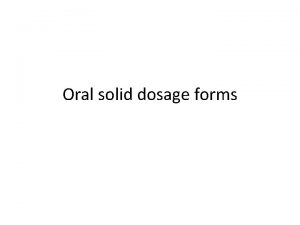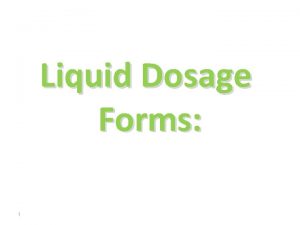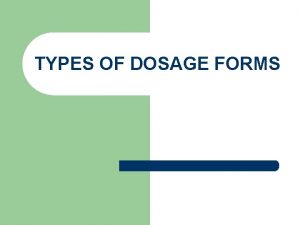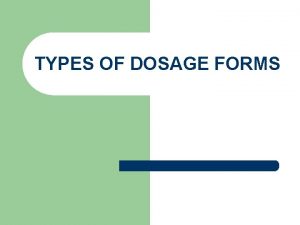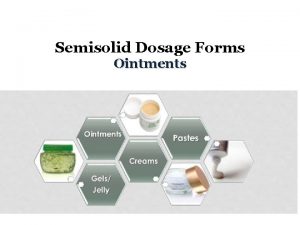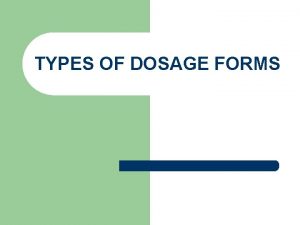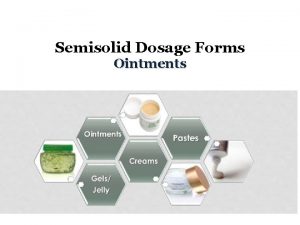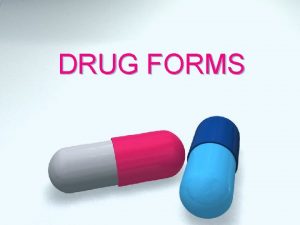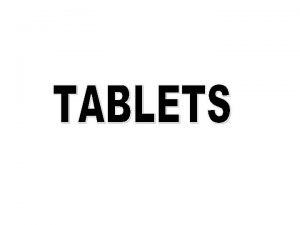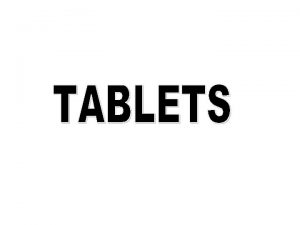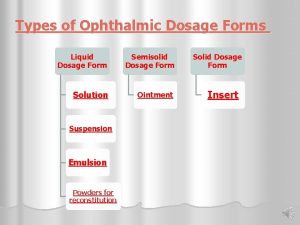II Solid Dosage Forms II Solid Dosage Forms


















- Slides: 18

II. Solid Dosage Forms

II. Solid Dosage Forms • Tablets • Capsules

1 - Tablets: • Are solid pharmaceutical dosage forms containing drug substances mostly with suitable diluents. • Advantages: • For manufacturer: 1 - Simplicity 2 - Economy of preparation 3 - Stability 4 - Convenience in packing, shipping • For the patient: 1. Accuracy of dosage 2. Portability 3. Ease of administration

1 - Tablets: cont… • Tablet shapes: 1 - Round 2 - Oblong 3 - Oval 4 - Cylindrical 5 - Triangular ………etc. • Method of preparation 1 - Moulding (old) 2 - Compression

1 - Tablets: cont… • • • Ingredients of compressed Tablets: The drug: active constituents Diluents: bulking agent Binder: adhere powder together Disintegrant : break down the tablet in G. I. T. Lubricant: prevent adherence of tablet and machine • Colourant or colouring agent: colouring the tablet's coat

Types of tablets: 1 - Sugar coated tablets: Are compressed tablets containing a sugar coat to: - help masking the bitter taste - protect the drug from oxidation or hydrolysis 2 - Film coated tablets: Are compressed tablets covered with a thin layer of a water soluble material. 3 - Enteric coated tablets: Tablets coated with substances that resist solution in gastric fluid but disintegrate in the intestine. This is useful for drugs inactivated in the stomach 4 - Multiple compressed tablets: Multilayered tablets made by compressing additional tablets granulation on a previously compressed granulations.

Types of tablets: cont… 5 - Controlled – release tablets: Compressed tablets formulated to release the drug slowly over a prolonged period of time 6 - Effervescent tablets: Compressed tablets containing sodium bicarbonate with organic acid such as citric acid or tartaric acid. In presence of water they release carbon dioxide which produces effervescence 7 - Compressed suppositories or inserts: Occasionally vaginal e. g. metronidazol vag. Tablets prepared by compression

Types of tablets: cont… 8 - Bucchal tablets Are small, flat, oval tablets intended for bucchal administration. It dissolves or erodes slowly e. g. progesterone 9 - Sublingual tablets: Tablets placed under the tongue to dissolve rapidly to give a quick action e. g. nitroglycerin tables 10 - Chewable tablets: Tablets intended to be chewed where mastication ensures breaking up the tablet and diffusion of the drug in the mouth then absorption Flavoring and sweetening agents are usually added to chewable tablets

2. Capsules: • Are solid dosage forms in which the drug substance is endorsed in either hard or soft shell formed from gelatin • Advantages: • Are tasteless • Are easily administered • Manufactured easily • In pharmaceutical industry about 23% of the solid dosage forms are hard gelatin capsules and 2% are soft gelatin capsules. • Soft gelatin capsules are soft, globular, gelatin shell thicker than hard capsules.

2. Capsules: • The shell of soft gelatin capsule is made of gelatin, glycerin and sorbitol with a preservative to prevent fungi growth. • Soft gelatin capsules are of different sizes and shapes. They may be round, oval, oblong, tubular and the contents may be liquid, paste or powder. • The hard capsules are of definite sizes, named 00, 0, 1, 2, 3 mainly with a cap and bottom and mainly filled with powder, granules or pellets

III. Semisolid Dosage Forms 1 - Ointments: Are semisolid preparations for external use applied to the skin. They function therapeutically as protective, emollients to the skin and for topical application of medicine to the skin. They may be applied to the eye. 2 - Creams: Are viscous liquid or semisolid emulsions of either O/W or W/O type Cream of O/W include shaving creams, hand creams Cream of W/O include cold creams and emollient creams

III. Semisolid Dosage Forms cont… 3 - Pastes: Are semisolid dosage forms containing drug substance for topical application. They are divided into: 1. Fatty pastes e. g. zinc oxide pastes 2. Pastes made from aqueous gel Pastes are often used in treatment of oozing lesions to absorb serious secretions.

IV. Molded solid dosage forms: • Suppositories and pessaries • Are solid dosage forms of various weights and shapes, usually medicated for insertion into the rectum, vagina or urethra. • After insertion they soften, melt, disperse or dissolve in the cavity fluids. • Suppositories are suitable for pediatric and geriatric patients. • Suppositories provide either a local or systemic therapeutic effect.

V. Sterile Dosage Forms 1 - Parenteral Preparations Differ from all other dosage forms because of the unique requirements. They are injected directly into body tissue through the skin and mucous membrane. They must be sterile and free from physical, chemical and biological contaminants. Many recent drugs specially derived from biotechnology can be given parentrally as they are inactivated when given orally.

V. Sterile Dosage Forms cont… Injections can be: Solutions Suspensions Emulsions Dry soluble or insoluble powder ready to be combined with a solvent just before use Route of administration: Intravenous Intramuscular Subcutaneous Intradermal Intraarticular Intrathecal • The nature of the product will determine the particular route of administration.

V. Sterile Dosage Forms cont… Advantages of Injection: Immediate action Drugs which can not be given orally because of the unconscious or uncooperative state or because inactivation in G. I. T. , could be given parentrally. Disadvantages: Requirement of asepsis at administration Risk of toxicity from local irritation Psychological pain factor Correction of error is impossible

2 - Ophthalmic preparations • Are sterile, isotonic, buffered products free from foreign particles suitable for installation to eyes. They include: - Solutions - Suspensions - Ointments • Solutions and suspensions mostly are aqueous • Any product intended for the eye must be sterile

2 - Ophthalmic preparations cont… The physiology of the human eye imposes more rigid formulation to be considered as: 1 - Sterility 2 - Stability 3 - Clarity 4 - Buffer 5 - p. H 6 - Tonicity 7 - Viscosity 8 - Comfort 9 - Additives 10 - Particle size 11 - Preservative 12 - Packaging
 Monophasic liquid dosage form
Monophasic liquid dosage form Evaluation parameters of ointment
Evaluation parameters of ointment Oleaginous base examples
Oleaginous base examples Monophasic liquid dosage form
Monophasic liquid dosage form Pencil shaped suppository
Pencil shaped suppository Properties of hydrocarbon bases
Properties of hydrocarbon bases Solid
Solid Manufacturing of pharmaceutical of semisolid dosage forms
Manufacturing of pharmaceutical of semisolid dosage forms Advantages of semi solid dosage form
Advantages of semi solid dosage form Semi solid dosage form definition
Semi solid dosage form definition Liquid dosage forms examples
Liquid dosage forms examples Capsule sizes
Capsule sizes Suppository solid dosage form
Suppository solid dosage form Dosage forms and drug delivery systems
Dosage forms and drug delivery systems Sugar coated tablet example
Sugar coated tablet example Evaluation of paste
Evaluation of paste Naloxone dosage forms
Naloxone dosage forms Dosage forms and drug delivery systems
Dosage forms and drug delivery systems Simplest dosage form
Simplest dosage form
